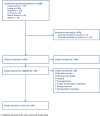Antibiotic prophylaxis for childbirth-related perineal trauma: A systematic review and meta-analysis
- PMID: 40344566
- PMCID: PMC12064200
- DOI: 10.1371/journal.pone.0323267
Antibiotic prophylaxis for childbirth-related perineal trauma: A systematic review and meta-analysis
Abstract
Introduction: Childbirth-related perineal trauma affects the vast majority of women who give birth vaginally and subsequent complications such as wound infection occur frequently. Antibiotic prophylaxis is not currently recommended following first or second degree tears, or episiotomies. We aimed to evaluate the effectiveness of prophylactic antibiotics for preventing complications from perineal trauma across all types of childbirth-related perineal trauma.
Materials and methods: Databases were searched from inception to February 2024. Randomised controlled trials, non-randomised interventional studies and observational studies were eligible for inclusion where women experienced childbirth-related perineal trauma and received antibiotic prophylaxis or placebo, including any type of tear or episiotomy. The primary outcome was perineal wound infection. Results were combined into meta-analysis using a random effects model.
Results: 14 studies were eligible for inclusion (eight randomised controlled trials, six observational) involving 8,878 women. Ten studies were deemed to have a high overall risk of bias. Overall the GRADE certainty of findings were low. Twelve studies were included in the analysis for perineal wound infection, involving 8,438 women. There was a reduced rate of perineal wound infection when prophylactic antibiotics were received (relative risk 0.57, 95% confidence interval 0.48 to 0.67). The subgroup analysis by type of tear demonstrated association with reduced risk of infection when prophylactic antibiotics were received, in the non-obstetric anal sphincter injuries combined subgroup (relative risk 0.50, 95% confidence interval 0.41-0.63) and the episiotomy only subgroup (relative risk 0.57, 95% confidence interval 0.36-0.91).
Conclusions: Prophylactic antibiotics are associated with a reduced risk of perineal wound infection. Despite these findings, there are not sufficient high-quality randomised controlled trials to adequately inform guideline change amongst women with first/second degree tears or episiotomies. We recommend that an adequately powered, robust, randomised controlled trial is needed amongst women with first/second degree tears or episiotomies after spontaneous birth.
Copyright: © 2025 Armstrong et al. This is an open access article distributed under the terms of the Creative Commons Attribution License, which permits unrestricted use, distribution, and reproduction in any medium, provided the original author and source are credited.
Conflict of interest statement
The authors have declared that no competing interests exist.
Figures






Similar articles
-
Antibiotic prophylaxis for operative vaginal delivery.Cochrane Database Syst Rev. 2020 Mar 26;3(3):CD004455. doi: 10.1002/14651858.CD004455.pub5. Cochrane Database Syst Rev. 2020. PMID: 32215906 Free PMC article.
-
Factors associated with infection after operative vaginal birth-a secondary analysis of a randomized controlled trial of prophylactic antibiotics for the prevention of infection following operative vaginal birth.Am J Obstet Gynecol. 2023 Mar;228(3):328.e1-328.e11. doi: 10.1016/j.ajog.2022.08.037. Epub 2022 Aug 24. Am J Obstet Gynecol. 2023. PMID: 36027955 Clinical Trial.
-
Perineal techniques during the second stage of labour for reducing perineal trauma and postpartum complications.Cochrane Database Syst Rev. 2024 Oct 28;10(10):CD016148. doi: 10.1002/14651858.CD016148. Cochrane Database Syst Rev. 2024. PMID: 39465967 Free PMC article.
-
Local cooling for relieving pain from perineal trauma sustained during childbirth.Cochrane Database Syst Rev. 2020 Oct 9;10(10):CD006304. doi: 10.1002/14651858.CD006304.pub4. Cochrane Database Syst Rev. 2020. PMID: 33034900 Free PMC article.
-
The use of metronidazole in women undergoing obstetric anal sphincter injuries: a systematic review of the literature.Arch Gynecol Obstet. 2020 Aug;302(2):321-328. doi: 10.1007/s00404-020-05651-x. Epub 2020 Jun 20. Arch Gynecol Obstet. 2020. PMID: 32564129
References
Publication types
MeSH terms
Substances
LinkOut - more resources
Full Text Sources
Medical

